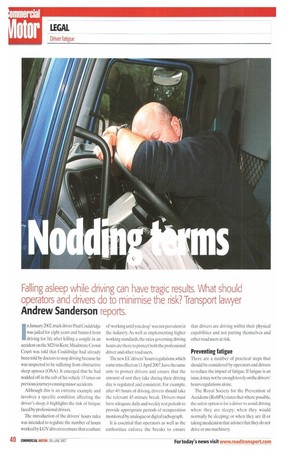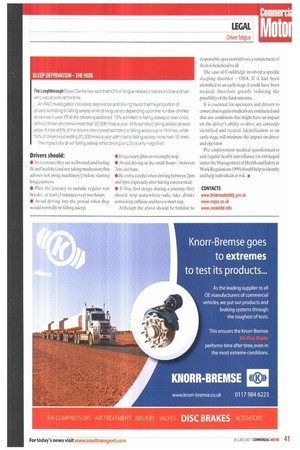There are a number of practical steps that should be
Page 40

Page 41

If you've noticed an error in this article please click here to report it so we can fix it.
considered by operators and drivers to reduce the impact of fatigue. If fatigue is an issue,it may not be enough to rely on the drivers' hours regulations alone.
The Royal Society for the Prevention of Accidents (RoSPA) states that where possible, the safest option is for a driver to avoid driving when: they are sleepy; when they would normally be sleeping; or when they are ill or taking medication that advises that they do not drive or use machinery.
Drivers should:
• Liy to ensure they are well rested, and feeling fit and healthy (and not taking medication that advises not using machinery), before starting long journeys.
• Plan the journey to include regular rest breaks— at least 15 minutes even' two hours.
• Avoid driving into the period when they would normally be falling asleep. • If necessary, plan an overnight stop.
• Avoid driving in the small hours — between 2atn and Sam.
• Be extra careful when driving between 2pm and 4pm, especially after having eaten a meal.
• If they feel sleepy during a journey, they should stop somewhere safe, take drinks containing caffeine and have a short nap. Although the above should be familiar to responsible operators/drivers, a restatement of them is beneficial to all.
The ease of Couldridge involved a specific sleeping disorder — USA. If it had been identified at an early stage it could have been treated, therefore greatly reducing the possibility of the fatal outcome.
It is essential for operators and drivers to ensure that regular medicals are conducted and that any conditions that might have an impact on the driver's ability to drive are correctly identified and treated. Identification at an early stage will minimise the impact on driver and operator.
Pre-employment medical questionnaires and regular health surveillance (as envisaged under the Management of Health and Safety at Work Regulations 1999) should help to identify and help individuals at risk. • CONTACTS www.thinkroadsalely.gov,uk www,rospa.co.uk www.awakeild. into






























































































































































































